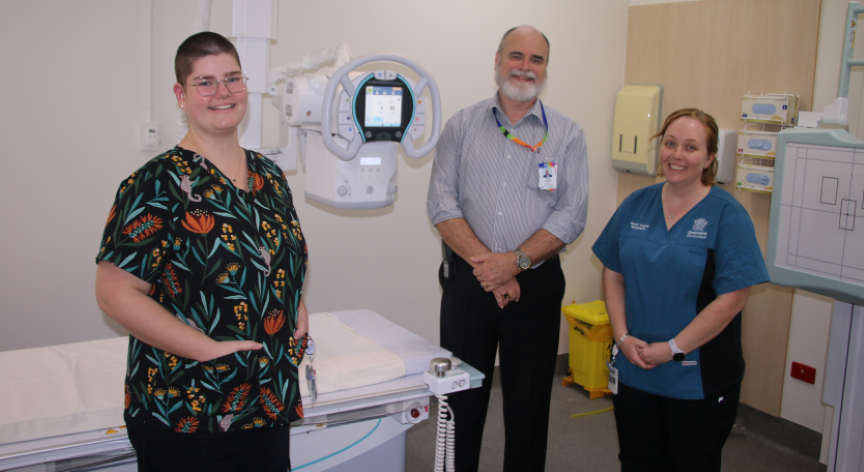
Digital X-ray uses robotic programming that is specific to each patient to position itself, which is more accurate and quicker when taking medical images.
This is also safer as it limits exposure to radiation due to less time under X-ray and reducing instances where images need to be retaken.
- The Palaszczuk Government is investing in diagnostic services for Bundaberg Hospital patients with an $800,000 upgrade of medical imaging technology.
- Bundaberg Hospital has installed two new digital X-ray machines which are now up and running, providing improved services to patients.
- Digital X-ray is faster and more accurate than conventional medical imaging technology, and limits exposure to radiation.
Two cutting edge digital X-ray machines are now helping to accurately diagnose patients quickly and safely at Bundaberg Hospital.
Minister for Health and Ambulance Services Shannon Fentiman toured Bundaberg Hospital today to observe the new digital X-ray machines in operation and witness the difference they are making to patients.
The $800,000 upgrade has resulted in shorter wait times for an X-ray at Bundaberg Hospital. This minimises the time a patient needs to spend in medical imaging, enabling them to return to where they are being cared for by a clinical team.
Digital X-ray uses robotic programming that is specific to each patient to position itself, which is more accurate and quicker when taking medical images.
The reduced time under X-ray and reduced need for retaking images means that the patient’s exposure to radiation is limited, making the overall process safer.
Quotes attributable to Health Minister, Shannon Fentiman:
“The new X-ray machines provide faster and more accurate digital images which enable patients to be safely diagnosed and begin their treatment sooner.”
“We know that Bundaberg locals deserve the best – that is why we are investing in healthcare and achieving improved outcomes for the Bundaberg community.
“It doesn’t just mean improved patient experiences. It also means providing our healthcare professionals with the tools they need to make the job easier.”
“The doctors and nurses of Bundaberg are committed to supporting locals, which is why I am committed to supporting them.”
“I want to thank Tom Smith MP for his tireless advocacy for his community and dedication to delivering better outcomes for Bundaberg.”
Quotes Attributable to Member for Bundaberg, Tom Smith:
“This is a game-changing investment into healthcare in the Bundaberg region as it gives our patients access to the latest medical imaging technology.
“These machines use digital programming and a robotic movement to ensure the machine is in place for each patient and providing the most accurate images in a quick and safe manner.
“It’s another step forward in technology which means Bundaberg patients will now have X-rays within seconds.
“The end result is faster, safer and more accurate X-ray services for the patients Bundaberg Hospital supports each and every day.”
Quotes attributable to Board Chair, Peta Jamieson:
“The installation of digital X-rays aligns with the health service’s strategic plan aims of embedding technology and equality of health care access for the community.
“The upgrade to digital X-ray provides a significant improvement in Bundaberg Hospital’s diagnostic capabilities using the latest technology to improve medical imaging services to local patients.
“It’s an example of the Wide Bay Hospital and Health Service (WBHHS) embedding the latest technology to benefit our patients, ensuring they have access to the high-quality diagnostic service they have would if they lived near a tertiary hospital in South East Queensland.”
Quotes attributable to WBHHS Chief Executive, Debbie Carroll:
“This is an example of harnessing technological advancements to provide top-quality medical services to all residents.
“For our medical teams, digital X-rays offer improved accuracy and quicker turnaround times for radiology examinations, enabling them to make well-informed decisions promptly.
“Our patients also benefit as more efficient imaging means they can return more quickly to the emergency department or inpatient ward where they are supported by the clinical team who are looking after them in the most appropriate environment.”